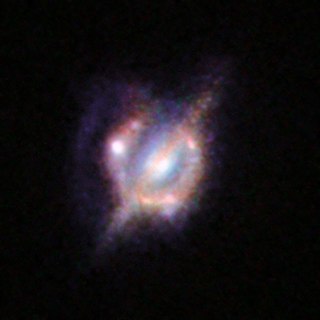Aug 27 2014
Using the Atacama Large Millimeter/submillimeter Array (ALMA), and many other telescopes on the ground and in space, an international team of astronomers has obtained the best view yet of a collision that took place between two galaxies when the Universe was only half its current age.
 Merging galaxies in the distant Universe through a gravitational magnifying glass
Merging galaxies in the distant Universe through a gravitational magnifying glass
They enlisted the help of a galaxy-sized magnifying glass to reveal otherwise invisible detail. These new studies of the galaxy H-ATLAS J142935.3-002836 have shown that this complex and distant object looks like the well-known local galaxy collision, the Antennae Galaxies.
The famous fictional detective Sherlock Holmes used a magnifying lens to reveal barely visible but important evidence. Astronomers are now combining the power of many telescopes on Earth and in space with a vastly larger form of cosmic lens to study a case of vigorous star formation in the early Universe.
“While astronomers are often limited by the power of their telescopes, in some cases our ability to see detail is hugely boosted by natural lenses, created by the Universe,” explains lead author Hugo Messias of the Universidad de Concepción (Chile) and the Centro de Astronomia e Astrofísica da Universidade de Lisboa (Portugal). “Einstein predicted in his theory of general relativity that, given enough mass, light does not travel in a straight line but will be bent in a similar way to light refracted by a normal lens.”
These cosmic lenses are created by massive structures like galaxies and galaxy clusters, which deflect the light from objects behind them due to their strong gravity — an effect, called gravitational lensing. The magnifying properties of this effect allow astronomers to study objects which would not be visible otherwise and to directly compare local galaxies with much more remote ones, seen when the Universe was significantly younger.
But for these gravitational lenses to work, the lensing galaxy, and the one far behind it, need to be very precisely aligned.
“These chance alignments are quite rare and tend to be hard to identify,” adds Hugo Messias, “but, recent studies have shown that by observing at far-infrared and millimetre wavelengths we can find these cases much more efficiently.”
H-ATLAS J142935.3-002836 (or just H1429-0028 for short) is one of these sources and was found in the Herschel Astrophysical Terahertz Large Area Survey (H-ATLAS). Although very faint in visible light pictures, it is among the brightest gravitationally lensed objects in the far-infrared regime found so far, even though we are seeing it at a time when the Universe was just half its current age.
Probing this object was at the limit of what is possible, so the international team of astronomers started an extensive follow-up campaign using the most powerful telescopes — both on the ground as well as in space — including the NASA/ESA Hubble Space Telescope, ALMA, the Keck Observatory, the Karl Jansky Very Large Array (JVLA), and others. The different telescopes provided different views, which could be combined to get the best insight yet into the nature of this unusual object.
The Hubble and Keck images revealed a detailed gravitationally-induced ring of light around the foreground galaxy. These high resolution images also showed that the lensing galaxy is an edge-on disc galaxy — similar to our galaxy, the Milky Way — which obscures parts of the background light due to the large dust clouds it contains.
But this obscuration is not a problem for ALMA and the JVLA, since these two facilities observe the sky at longer wavelengths, which are unaffected by dust. Using the combined data the team discovered that the background system was actually an ongoing collision between two galaxies. From this point on, ALMA and the JVLA started to play a key role in further characterising this object.
In particular, ALMA traced carbon monoxide, which allows detailed studies of star formation mechanisms in galaxies. The ALMA observations also allowed the motion of the material in the more distant object to be measured. This was essential to show that the lensed object is indeed an ongoing galactic collision forming hundreds of new stars each year, and that one of the colliding galaxies still shows signs of rotation; an indication that it was a disc galaxy just before this encounter.
The system of these two colliding galaxies resembles an object that is much closer to us: the Antennae Galaxies. This is a spectacular collision between two galaxies, which are believed to have had a disc structure in the past. While the Antennae system is forming stars at a rate of only a few tens of the mass of our Sun each year, H1429-0028 turns more than 400 times the mass of the Sun of gas into new stars each year.